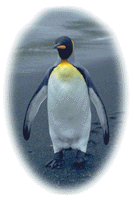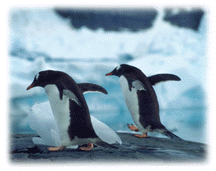Penguins
 The signature species of Antarctica -- the mascot, if you will -- is
the penguin. There are not one but no fewer than 17 species of
penguins, of which only four breed on the Antarctic continent
itself. These include the Adelie, the Emperor, the Chinstrap and the
Gentoo penguins. Several other species are sometimes found within the
Antarctic region, and penguins are found as far north as the Galapagos
Islands, straddling the equator. But in general, the link in the
public imagination between Antarctica and penguins is supported by the
numbers -- there are millions of nesting pairs of Chinstrap penguins
alone, and they are by far the most numerous creatures in the region.
The signature species of Antarctica -- the mascot, if you will -- is
the penguin. There are not one but no fewer than 17 species of
penguins, of which only four breed on the Antarctic continent
itself. These include the Adelie, the Emperor, the Chinstrap and the
Gentoo penguins. Several other species are sometimes found within the
Antarctic region, and penguins are found as far north as the Galapagos
Islands, straddling the equator. But in general, the link in the
public imagination between Antarctica and penguins is supported by the
numbers -- there are millions of nesting pairs of Chinstrap penguins
alone, and they are by far the most numerous creatures in the region.

Penguins are flightless birds which have adapted to living in the
cooler waters of the Southern Hemisphere. The 17 species of penguins
found today are thought to have evolved from petrel-like flying birds
some 50 million years ago. Some species spend as much as 75% of their
lives in the ocean, yet they all breed on land or sea-ice attached to
the land.
 All penguins have a very similar torpedo-shaped body form, though
they vary greatly in size. Penguin wings are highly modified to form
stiff paddle-like flippers used for swimming, and their feet and
stubby tails combine to form a rudder. The penguin's bones are solid
and heavy, which help them to remain submerged and reduce the energy
needed for diving.
All penguins have a very similar torpedo-shaped body form, though
they vary greatly in size. Penguin wings are highly modified to form
stiff paddle-like flippers used for swimming, and their feet and
stubby tails combine to form a rudder. The penguin's bones are solid
and heavy, which help them to remain submerged and reduce the energy
needed for diving.

Penguins are able to withstand the extreme cold because insulation
provided by their short, densely-packed feathers forms a waterproof
coat. A thick layer of fat or blubber also serves as an energy
store. These adaptations, among others, enable them to minimize heat
loss in icy cold waters so they can cope with the harsh conditions of
the Antarctic.
 All penguins have a very similar torpedo-shaped body form, though
they vary greatly in size. Penguin wings are highly modified to form
stiff paddle-like flippers used for swimming, and their feet and
stubby tails combine to form a rudder. The penguin's bones are solid
and heavy, which help them to remain submerged and reduce the energy
needed for diving.
All penguins have a very similar torpedo-shaped body form, though
they vary greatly in size. Penguin wings are highly modified to form
stiff paddle-like flippers used for swimming, and their feet and
stubby tails combine to form a rudder. The penguin's bones are solid
and heavy, which help them to remain submerged and reduce the energy
needed for diving.

 The signature species of Antarctica -- the mascot, if you will -- is
the penguin. There are not one but no fewer than 17 species of
penguins, of which only four breed on the Antarctic continent
itself. These include the Adelie, the Emperor, the Chinstrap and the
Gentoo penguins. Several other species are sometimes found within the
Antarctic region, and penguins are found as far north as the Galapagos
Islands, straddling the equator. But in general, the link in the
public imagination between Antarctica and penguins is supported by the
numbers -- there are millions of nesting pairs of Chinstrap penguins
alone, and they are by far the most numerous creatures in the region.
The signature species of Antarctica -- the mascot, if you will -- is
the penguin. There are not one but no fewer than 17 species of
penguins, of which only four breed on the Antarctic continent
itself. These include the Adelie, the Emperor, the Chinstrap and the
Gentoo penguins. Several other species are sometimes found within the
Antarctic region, and penguins are found as far north as the Galapagos
Islands, straddling the equator. But in general, the link in the
public imagination between Antarctica and penguins is supported by the
numbers -- there are millions of nesting pairs of Chinstrap penguins
alone, and they are by far the most numerous creatures in the region.
